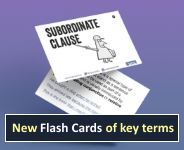Preposing and postposing
As writers and speakers there are many ways in which we can present information to readers or hearers by using different word orders and sentence patterns to highlight different aspects of meaning. This is often referred to as information structuring.
There are many ways we can highlight information. Here we will look at two important ones:
Welcome back!

Englicious is totally free for everyone to use!
But you will have to log in to see our library of teaching resources.
If you don’t have an account, that’s perfectly OK. You can register (for free).
It only takes a minute or two.

